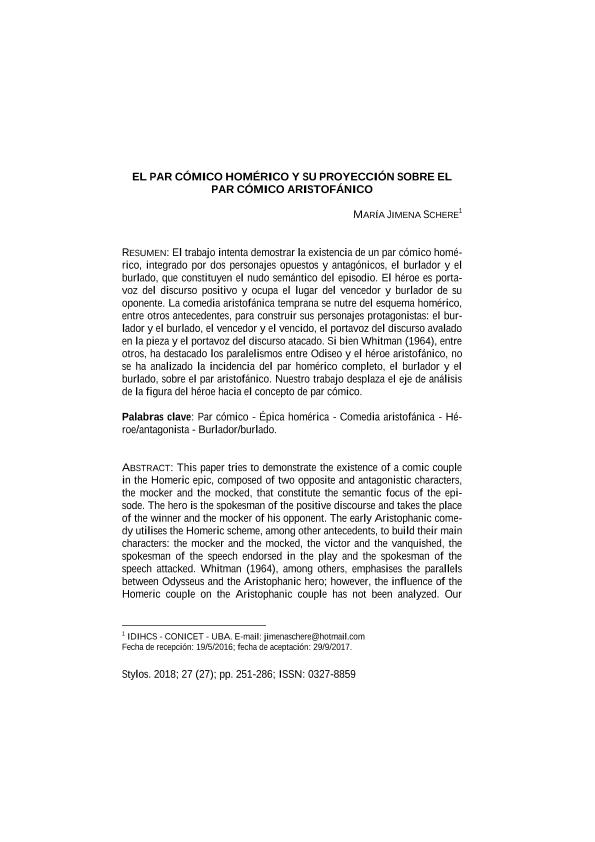Mostrar el registro sencillo del ítem
dc.contributor.author
Schere, María Jimena

dc.date.available
2019-10-22T18:33:31Z
dc.date.issued
2018-12
dc.identifier.citation
Schere, María Jimena; El par cómico homérico y su proyección sobre el par cómico aristofánico; Universidad Católica Argentina Santa María de los Buenos Aires. Facultad de Filosofía y Letras. Instituto de Estudios Grecolatinos "Prof. F. Novoa"; Stylos; 27; 27; 12-2018; 251-286
dc.identifier.issn
0327-8859
dc.identifier.uri
http://hdl.handle.net/11336/86953
dc.description.abstract
El trabajo intenta demostrar la existencia de un par cómico homérico, integrado por dos personajes opuestos y antagónicos, el burlador y el burlado, que constituyen el nudo semántico del episodio. El héroe es portavoz del discurso positivo y ocupa el lugar del vencedor y burlador de su oponente. La comedia aristofánica temprana se nutre del esquema homérico, entre otros antecedentes, para construir sus personajes protagonistas: el burlador y el burlado, el vencedor y el vencido, el portavoz del discurso avalado en la pieza y el portavoz del discurso atacado. Si bien Whitman (1964), entre otros, ha destacado los paralelismos entre Odiseo y el héroe aristofánico, no se ha analizado la incidencia del par homérico completo, el burlador y el burlado, sobre el par aristofánico. Nuestro trabajo desplaza el eje de análisis de la figura del héroe hacia el concepto de par cómico. En definitiva, analiza los personajes tópicos homéricos que inciden en la construcción del par aristofánico.
dc.description.abstract
This paper tries to demonstrate the existence of a comic couple in the Homeric epic, composed of two opposite and antagonistic characters, the mocker and the mocked, that constitute the semantic focus of the episode. The hero is the spokesman of the positive discourse and takes the place of the winner and the mocker of his opponent. The early Aristophanic comedy utilises the Homeric scheme, among other antecedents, to build their main characters: the mocker and the mocked, the victor and the vanquished, the spokesman of the speech endorsed in the play and the spokesman of the speech attacked. Whitman (1964), among others, emphasises the parallels between Odysseus and the Aristophanic hero; however, the influence of the Homeric couple on the Aristophanic couple has not been analyzed. Our analysis focuses the concept of comic couple instead of the concept of comic hero.
dc.format
application/pdf
dc.language.iso
spa
dc.publisher
Universidad Católica Argentina Santa María de los Buenos Aires. Facultad de Filosofía y Letras. Instituto de Estudios Grecolatinos "Prof. F. Novoa"
dc.rights
info:eu-repo/semantics/openAccess
dc.rights.uri
https://creativecommons.org/licenses/by-nc-sa/2.5/ar/
dc.subject
PAR CÓMICO
dc.subject
ÉPICA HOMÉRICA
dc.subject
COMEDIA ARISTOFÁNICA
dc.subject
HÉROE/ANTAGONISTA
dc.subject
BURLADOR/BURLADO
dc.subject.classification
Literaturas Específicas

dc.subject.classification
Lengua y Literatura

dc.subject.classification
HUMANIDADES

dc.title
El par cómico homérico y su proyección sobre el par cómico aristofánico
dc.type
info:eu-repo/semantics/article
dc.type
info:ar-repo/semantics/artículo
dc.type
info:eu-repo/semantics/publishedVersion
dc.date.updated
2019-10-16T14:29:13Z
dc.journal.volume
27
dc.journal.number
27
dc.journal.pagination
251-286
dc.journal.pais
Argentina

dc.journal.ciudad
Buenos Aires
dc.description.fil
Fil: Schere, María Jimena. Consejo Nacional de Investigaciones Científicas y Técnicas. Centro Científico Tecnológico Conicet - La Plata. Instituto de Investigaciones en Humanidades y Ciencias Sociales. Universidad Nacional de La Plata. Facultad de Humanidades y Ciencias de la Educación. Instituto de Investigaciones en Humanidades y Ciencias Sociales; Argentina
dc.journal.title
Stylos
dc.relation.alternativeid
info:eu-repo/semantics/altIdentifier/url/http://erevistas.uca.edu.ar/index.php/STY/article/view/2064
Archivos asociados
